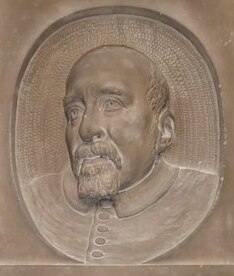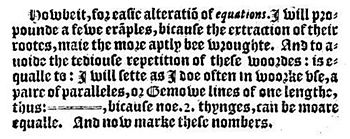Robert Recorde
 From Wikipedia - Reading time: 8 min
From Wikipedia - Reading time: 8 min
Robert Recorde | |
|---|---|
 Robert Recorde (c.1512–1558) | |
| Born | c. 1510 Tenby, Pembrokeshire, Wales |
| Died | June 1558 London, England |
| Nationality | Welsh |
| Alma mater | University of Oxford University of Cambridge |
| Known for | Inventing the equals sign (=) |
| Scientific career | |
| Fields | Physician and mathematician |
| Institutions | University of Oxford Royal Mint |
Robert Recorde (c. 1510 – 1558) was a Welsh[1][2] physician and mathematician. He invented the equals sign (=) and also introduced the pre-existing plus (+) and minus (−) signs to English speakers in 1557.
Biography
[edit]Born around 1510, Robert Recorde was the second and last son of Thomas and Rose Recorde[3] of Tenby, Pembrokeshire, in Wales.[4]
Recorde entered the University of Oxford about 1525, and was elected a Fellow of All Souls College there in 1531. Having adopted medicine as a profession, he went to the University of Cambridge to take the degree of M.D. in 1545. He afterwards returned to Oxford, where he publicly taught mathematics, as he had done prior to going to Cambridge. He invented the "equals" sign, which consists of two horizontal parallel lines, stating that no two things can be more equal. It appears that he afterwards went to London, and acted as physician to King Edward VI and to Queen Mary, to whom some of his books are dedicated. He was also controller of the Royal Mint and served as Comptroller of Mines and Monies in Ireland.[5] After being sued for defamation by a political enemy, he was arrested for debt and died in the King's Bench Prison, Southwark, by the middle of June 1558.
Publications
[edit]

Recorde published several works upon mathematical and medical subjects, chiefly in the form of dialogue between master and scholar, such as the following:
- The Grounde of Artes, teachings the Worke and Practise, of Arithmeticke, both in whole numbers and fractions (1543),[4] the first English language book on algebra.
- The Pathway to Knowledge, containing the First Principles of Geometry ... bothe for the use of Instrumentes Geometricall and Astronomicall, and also for Projection of Plattes (London, 1551)
- The Castle of Knowledge, containing the Explication of the Sphere both Celestiall and Materiall, etc. (London, 1556) A book explaining Ptolemaic astronomy while mentioning the Copernican heliocentric model in passing.
- The Whetstone of Witte, whiche is the seconde parte of Arithmeteke: containing thextraction of rootes; the cossike practise, with the rule of equation; and the workes of Surde Nombers (London, 1557). This was the book in which the equals sign was introduced within a printed edition.[6] With the publication of this book Recorde is credited with introducing algebra into the Island of Britain with a systematic notation.[7][8]
- A medical work, The Urinal of Physick (1548), frequently reprinted.[9]
Most of those works were written in the form of a catechism.[6] Several books whose authors are unknown have been attributed to him: Cosmographiae isagoge, De Arte faciendi Horologium and De Usu Globorum et de Statu temporum.[10]
See also
[edit]- Equality
- Equation
- History of mathematical notation
- St. Mary's Church, Tenby
- Welsh mathematicians
- Zenzizenzizenzic – a word to describe a number to the eighth power coined by Robert Recorde
Notes
[edit]- ^ Mazur, Joseph (21 May 2014). "Notation, notation, notation: a brief history of mathematical symbols". The Guardian. ISSN 0261-3077. Retrieved 5 May 2023.
- ^ Western Mail, Saturday 24 March 1928 - https://www.britishnewspaperarchive.co.uk/viewer/bl/0000104/19280324/188/0006
- ^ "Robert Recorde: the Welshman who invented equality". The National Wales. Archived from the original on 6 February 2022. Retrieved 6 February 2022.
- ^ a b Johnston, Stephen (2004). "Recorde, Robert (c. 1512–1558)". Oxford Dictionary of National Biography (online ed.). Oxford University Press. doi:10.1093/ref:odnb/23241. Retrieved 26 January 2012. (Subscription or UK public library membership required.)
- ^ Newman, James R. (1956). The World of Mathematics.
- ^ a b Smith, David Eugene (1 July 1917). "Medicine and Mathematics in the Sixteenth Century". Ann. Med. Hist. 1 (2): 125–140. OCLC 12650954. PMC 7927718. PMID 33943138. (here cited p. 131).
- ^ Jourdain, Philip E. B. (1913). The Nature of Mathematics.
- ^ Robert Recorde, The Whetstone of Witte (London, England: John Kyngstone, 1557), p. 236 (although the pages of this book are not numbered). From the chapter titled "The rule of equation, commonly called Algebers Rule" (p. 236): "Howbeit, for easie alteration of equations. I will propounde a fewe examples, bicause the extraction of their rootes, maie the more aptly bee wroughte. And to avoide the tediouse repetition of these woordes: is equalle to: I will sette as I doe often in worke use, a paire of paralleles, or Gemowe [twin, from gemew, from the French gemeau (twin / twins), from the Latin gemellus (little twin)] lines of one lengthe, thus: = , bicause noe .2. thynges, can be moare equalle." (However, for easy manipulation of equations, I will present a few examples in order that the extraction of roots may be more readily done. And to avoid the tedious repetition of these words "is equal to", I will substitute, as I often do when working, a pair of parallels or twin lines of the same length, thus: = , because no two things can be more equal.)
- ^ The Urinal of Physick, by Robert Recorde, 1548; at Google Books
- ^ John Hall, "An Historiall Expostulation", p. 60. In Early English Poetry, Ballads, and Popular Literature of the Middle Ages, v. XI. London: T. Richards, 1844
References
[edit]- This article incorporates text from a publication now in the public domain: Chisholm, Hugh, ed. (1911). "Recorde, Robert". Encyclopædia Britannica. Vol. 22 (11th ed.). Cambridge University Press. p. 966.
- James R. Newman (1956). The World of Mathematics Vol. 1 Commentary on Robert Recorde
- Philip E. B. Jourdain (1913). The Nature of Mathematics; 2013 Dover pbk reprint. ISBN 9780486458854. LCCN 2006052118.
- Gareth Roberts and Fenny Smith, editors (2012). Robert Recorde: The Life and Times of a Tudor Mathematician (University of Wales Press, distributed by University of Chicago Press) 232 pages
- Jack Williams (2011). Robert Recorde: Tudor Polymath, Expositor and Practitioner of Computation (Heidelberg, Springer) (History of Computing). pbk edition. ISBN 978-0-85729-861-4.
- J. W. S. Cassels (1976). Is This a Recorde?, The Mathematical Gazette Vol. 60 No. 411 March 1976 p 59-61 doi:10.2307/3615647
- Gordon Roberts (2016). Robert Recorde: Tudor Scholar and Mathematician (University of Wales Press, Scientists of Wales series). pbk edition. ISBN 978-1-78316-854-5.
- Frank J. Swetz and Victor J. Katz (2011). "Mathematical Treasures - Robert Recorde's Whetstone of Witte," Convergence (January 2011)
External links
[edit]- St. Andrew's University Maths History biography
- Robert Recorde: the Welshman who invented equality Archived 6 February 2022 at the Wayback Machine
- Robert Recorde and other Welsh Mathematicians
- 100 Welsh Heroes – Robert Recorde
- Earliest Uses of Symbols of Relation
- Earliest Known Uses of Some of the Words of Mathematics This contains numerous quotations from Recorde.
- RECORDE (Robert) in Charles Hutton's Mathematical and Philosophical Dictionary
- Robert Recorde's life and works on h2g2
- Current publisher of Robert Recorde's books in the form of original reproductions
- Works by Robert Record at Project Gutenberg
- Works by or about Robert Recorde at the Internet Archive
 KSF
KSF